 W
WAbobo's Big Adventure is a freeware parody flash game. Inspired by various video games released for the Nintendo Entertainment System, the game features Abobo, a boss character from the Double Dragon franchise, traveling through the worlds of several different games to save his son. Written by I-Mockery founder Roger Barr, programmed by Nick Pasto, with art and animation by PoxPower, Abobo's Big Adventure was released in January 2012 to positive critical reception.
 W
WAmerican Horseshoes is a 1 to 4 player "horseshoes" arcade game released by Taito in 1990. Each player can choose from one of four characters: Lucky Lou, Diamond Dave, Tossin' Tom and Mayhem Mary. There are two pitches in each inning. Players may select grip and throwing angle prior to each pitch. The rolling of the trackball determines the distance of each pitch. After each inning the scoring with shown with an overhead shot of the stake area. Each player's score is shown throughout the game at the top of the screen. Up to nine innings can be played per game.
 W
WAtaxx (アタックス) is a strategy video game that was published in arcades by The Leland Corporation in 1990. It also appeared the same year as Spot: The Video Game and later as the Microscope Puzzle from the 1993 CD-ROM game The 7th Guest. The game was invented by Dave Crummack and Craig Galley in 1988 and was originally called Infection. It was first programmed on Amiga, Commodore 64, and Atari ST.
 W
WBasketball is an arcade game released in May 1979 by Atari Inc. It was notable as the first basketball video game to make use of a trackball for player movement and the first to use the angled side view which became a commonly used perspective in the basketball video games that followed.
 W
WBig Event Golf is a golf arcade game released by Taito in 1986.
 W
WBirdie King (バーデイー・キング) is a golf arcade game franchise. The original game was released in 1982 by Taito. It was followed by two sequels: Birdie King 2 in 1983, and Birdie King 3 in 1984.
 W
WBlades of Steel, later released in Japan as Konamic Ice Hockey , is an ice hockey video game released by Konami for North American arcades in 1987, and ported to the Family Computer Disk System and Nintendo Entertainment System in 1988. All teams are fictional but based out of real Canadian and American cities. The game is known for its fast-paced hockey action and especially for the fighting. It is a one or two player game. When playing against the computer, there are three difficulty levels to choose from: Junior, College, and Pro. Each team consists of three forwards, two defencemen, and a goaltender.
 W
WCabal is a 1988 arcade video game originally developed by TAD Corporation and published in Japan by Taito Corporation and in North America and Europe by Fabtek. In the game, the player controls a commando, viewed from behind, trying to destroy various enemy military bases. The game was innovative for the era, but only a mild success in the arcades, and became better known for its various home conversions.
 W
WCapcom Bowling is a top down bowling simulation developed by Incredible Technologies and released to arcades in 1988 by Capcom. Up to 4 four players could play a single game playing alternately. The controls feature a trackball which is used to control both direction and power, and two buttons which control left and right spin or hook. Comedic animations play for making certain shots.
 W
WCentipede is a 1980 fixed shooter arcade game developed and published by Atari, Inc. It was designed by Dona Bailey and Ed Logg. It was one of the most commercially successful games from the golden age of arcade video games. The player fights off centipedes, spiders, scorpions and fleas, completing a round after eliminating the centipede that winds down the playing field. An arcade sequel, Millipede, followed in 1982.
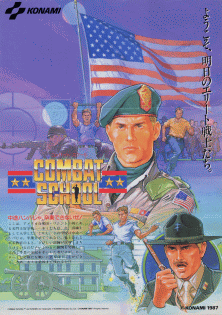 W
WCombat School, released as Boot Camp in North America, is a 1987 arcade game produced by Konami where the player takes control of a military recruit who is undergoing basic training at a United States Marine Corps Recruit Training camp, also known as a boot camp.
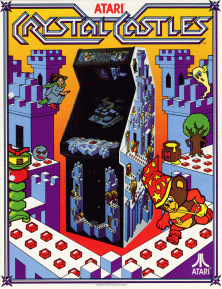 W
WCrystal Castles is an arcade game released by Atari, Inc. in 1983. The player controls Bentley Bear who has to collect gems located throughout trimetric-projected rendered castles while avoiding enemies, some of whom are after the gems as well. Crystal Castles is one of the first arcade action games with an ending, instead of continuing indefinitely, looping, or ending in a kill screen, and to contain advance warp zones.
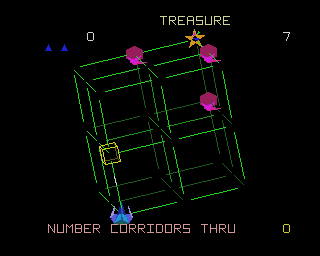 W
WCube Quest is an arcade game by American company Simutrek released in 1983. It combines 3D polygonal graphics with laserdisc-streamed, animated backgrounds. Along with Atari's I, Robot, it was one of the first arcade games to use 3D polygonal graphics. The primary designer and programmer was Paul Allen Newell, who previously wrote some Atari 2600 games.
 W
WFood Fight is an arcade game developed by General Computer Corporation and released by Atari, Inc. in March 1983. The player guides Charley Chuck, who is trying to eat an ice cream cone before it melts, while avoiding four chefs bent on stopping him. 1,951 arcade cabinets were sold.
 W
WFootball is a 2-player 1978 arcade and Atari 2600 console-game. It was developed and published by Atari, Inc.. In this game, the sport of American football is emulated, with players represented by Xs and Os. The game was one of the most popular arcade games in its day. In 1979, Atari released a more challenging four-player version of the arcade game programmed by Dave Theurer, the creator of Missile Command and Tempest.
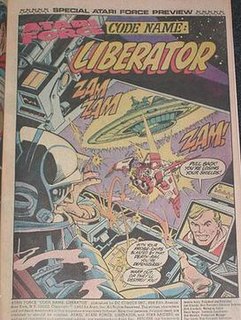 W
WLiberator is an arcade game released by Atari, Inc. in 1982. It is based on the Atari Force comic book series published by DC Comics from 1982 to 1986. Liberator has been described as the opposite of Missile Command, in that the player destroys cities from space instead of defending them from the ground. Only 762 arcade machines were ever made.
 W
WMarble Madness is an arcade video game designed by Mark Cerny and published by Atari Games in 1984. It is a platform game in which the player must guide a marble through six courses, populated with obstacles and enemies, within a time limit. The player controls the marble by using a trackball. Marble Madness is known for using innovative game technologies: it was Atari's first to use the Atari System 1 hardware, the first to be programmed in the C programming language, and one of the first to use true stereo sound.
 W
WMillipede is fixed shooter video game released in arcades by Atari, Inc. in 1982. It is the sequel to the arcade game Centipede with more gameplay variety and a wider array of insects than the original. The objective is to score as many points as possible by destroying all segments of the millipede as it moves toward the bottom of the screen, as well as eliminating or avoiding other enemies. The game is played with a trackball and a single fire button which can be held down for rapid-fire.
 W
WMissile Command is a 1980 arcade game developed and published by Atari, Inc. and licensed to Sega for European release. It was designed by Dave Theurer, who also designed Atari's vector graphics game Tempest from the same year. The 1981 Atari 2600 port of Missile Command by Rob Fulop sold over 2.5 million copies.
 W
WOrbatak is a video game developed and published by American Laser Games for the arcade. A 3DO Interactive Multiplayer version was announced but never released.
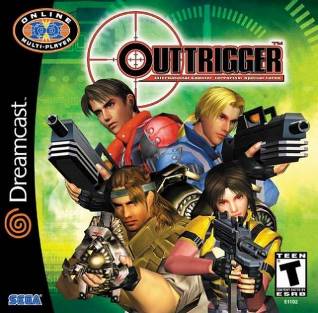 W
WOuttrigger is a first/third-person shooter video game developed by Sega AM2 for the Sega NAOMI arcade cabinet and the Dreamcast. The game was originally released in 1999 for the arcades and was later ported over to the Dreamcast in 2001. The player character of Outtrigger is a member of an anti-terrorist group, and can be chosen between default characters with different specialties or a custom character, and can utilize a number of power-ups. Reception to Outtrigger was generally positive, praising the gameplay and mechanics, though criticizing the removal of online play in the European version of the game.
 W
WPeter Jacobsen's Golden Tee 3D Golf is a video game developed and published by Incredible Technologies for the arcade. It was later ported to PlayStation and Windows. It is based on the popularity of golfer Peter Jacobsen.
 W
WQuantum is a color vector arcade game designed by General Computer Corporation for Atari Inc. and released in December 1982. The premise of the game is related loosely to quantum physics in that the player directs a probe with a trackball to encircle atomic "particles" for points, without touching various other particles. Once the particles are surrounded by the probe's tail they are destroyed.
 W
WRampart is an arcade game, released in 1990 by Atari Games, that combines the shoot 'em up and puzzle genres. It was first made available as an arcade game but was subsequently offered for a number of home gaming platforms. The game is considered a precursor to the tower defense genre.
 W
WReactor is a raster video arcade game released in 1982 by Gottlieb. The object of the game is to cool down the reactor core without being hurled by magnetism and repulsion by enemy swarms of nuclear particles. The game was ported to the Atari 2600 by Charlie Heath and published by Parker Brothers the same year.
 W
WSDI - Strategic Defense Initiative, or simply titled SDI and sometimes known as Global Defense, is a 1987 horizontally scrolling shooter produced and released internationally in arcades by Sega. It was later ported to home computers and game consoles, some by other companies. Players control a satellite and must destroy enemies by moving a crosshair over them and firing the satellite's weapons.
 W
WSegaSonic the Hedgehog is a 1993 arcade game in the Sonic the Hedgehog series by Sega. Controlling Sonic the Hedgehog and his friends Mighty the Armadillo and Ray the Flying Squirrel, the player must escape an island as quickly as possible after they are kidnapped by series antagonist Doctor Eggman. The game is presented from an isometric perspective and players use a trackball to move the characters while dodging obstacles and collecting rings. The game was developed by Sega's arcade division, Sega AM3; it is one of four Sonic games to bear the SegaSonic name and was inspired by the 1984 game Marble Madness.
 W
WSpace Paranoids is a first-person shooter arcade game appearing and featured in the 1982 movie Tron. According to the plot, it was created by Kevin Flynn but the code was stolen and released by ENCOM and the villain Ed Dillinger. In the movie Flynn is seen playing the game in his arcade.
 W
WSyvalion is an arcade shooter video game released by Taito in 1988 and designed by Fukio Mitsuji, creator of Bubble Bobble. The player controls a golden metal dragon which flies around, breathing fire at its enemies while collecting power-ups to recharge its fire. The enemies are robots and tanks. At the end of each level, the player fights a boss.
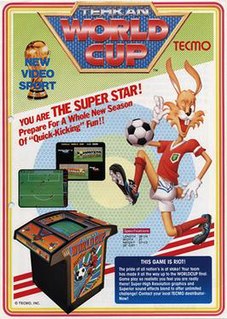 W
WTehkan World Cup is a multi-player soccer game featuring a trackball controller. Programmed by Michishito Ishizuka it was released to arcades in 1985 by Tehkan, Ltd., the former name of Tecmo, Inc. Its arrival coincided with the buildup to the 1986 FIFA World Cup. It featured the then colors of several of the world's top teams such as West Germany, Argentina and Brazil, although it did not mention any team by name. It was most commonly released in a cocktail cabinet form factor, while graphically it offered a two-dimensional birds-eye view of the field that was unique for its time. Its trackball control system contributed significantly to its gameplay which was relatively speedy and exhibited a fluidity something akin to ice hockey, with as little as 3 seconds required to score from kick-off. Two-player action could be highly competitive, with players facing each other across the game space while using sweeping arm movements reminiscent of table tennis.
 W
WTempest 2000 is a tube shooter video game originally developed by Llamasoft and published by Atari Corporation for the Atari Jaguar in North America on 13 April, 1994. It was later released in Europe on 27 June of the same year and finally in Japan on 15 December of the same year as well, where it was published by Mumin Corporation. Part of Atari Corp.'s 2000 series, it is a remake by Jeff Minter of Dave Theurer's 1981 arcade game Tempest, which used Atari's QuadraScan vector color display technology.
 W
WTrack & Field is an Olympic-themed sports arcade game developed by Konami and released in 1983. The Japanese release sported an official license for the 1984 Summer Olympics. Players compete in a series of events, most involving alternately pressing two buttons as quickly as possible to make the onscreen character run faster. It was followed by Hyper Sports and other games in the series.
 W
WThe Wizard of Oz: Beyond the Yellow Brick Road, known in Japan as RIZ-ZOAWD, is a role-playing video game developed by Japanese developer Media.Vision for the Nintendo DS. The game is an adaptation of L. Frank Baum's 1900 novel The Wonderful Wizard of Oz, using its characters, locations and plot. The game was originally published in Japan by D3 Publisher on December 25, 2008. Xseed Games published the game in North America on September 29, 2009.